Pokemon Biology - The Swamp
| « Previous Article | Home | Next Article » |
Intro

Swamps are important ecological hotspots. Many different species of Pokémon live in the swamp and coexist. Swamps are wetland areas that are covered by trees and occasionally get flooded. Some noticeable swamps around the Pokémon world are the Great Marsh near Pastoria City in Sinnoh, Route 14 in Kalos, and Route 3 in Unova. My fellow Poké-zookeeper, anto, and I will talk about the importance of a few species that are commonly found in the swamp.
Some Pokémon
Yanma
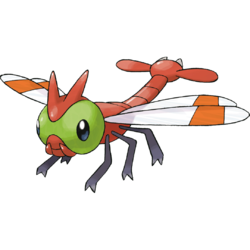

Yanma resemble dragonflies, with the only difference being that they are a few inches longer than regular dragonflies. But the resemblance is not just because of the way they look, but also due to their behavior in nature. Yanma, as well as dragonflies, can commonly be found in big swarms when they are migrating or feeding. And when it comes to the latter, as these little guys are not strong enough, they need to feed on smaller bugs that live around the swamps, such as baby Surskit and Kricketot. Newborn Yanma's targets are Tympole and fish such as Finneon and Feebas. Yanma are as much prey as they are hunters, though, as Yanmega's diets consist of tiny Yanma that can't find their way home.
This species is very territorial. To protect what is theirs, they'll fly in loops in order to intimidate foes. What's impressive is that these little bugs can fly at a very high speed, but they can also stop and turn around during flight, giving Yanma a 360° perspective.
Politoed
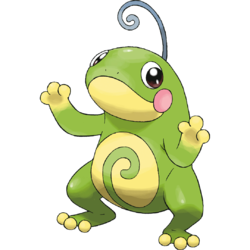

Frogs are a vital part of the ecosystem. In the middle of the food chain, Politoed and their offspring serve as prey for larger Pokémon, such as Feraligatr and Whiscash, while at the same time preying on smaller Pokémon such as Yanma and Wooper. This keeps the smaller Pokémon populations in check while feeding the larger ones. Politoed and other frogs also eat many Pokémon that we consider pests, such as Spinarak, Beedrill, and Rattata, so they are beneficial to humans. Another reason is that they can indicate if water is polluted or contaminated. Because amphibians breathe and drink through their skin, the chemicals and pollutants enter their body quickly. If there are no frogs or only sick frogs in a swamp or near a pond, there might be a problem with it.
Frogs around the world are in trouble, as over one-third of them is threatened with extinction. Save the frogs!
Bibarel
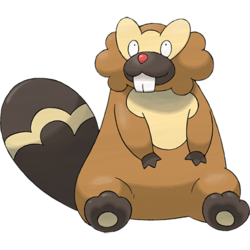

Don't let their silly faces fool you. These quite friendly and smart beavers didn't need five years of college, and Bibarel are still the engineers of the ecosystem. They'll chew on tree trunks halfway through and they'll let the wind do the rest: as the structure of a tree is pretty frail after that, it will just drop to the ground. Once they're near Bibarel's reach, these hard workers will steal the branches and logs. With them inside their mouths, they'll swim across the river to where the dams are and they'll just stack them all together. Stones will be put on the base of the dam to keep its structure, and mud from the bottom of the river will seal it; their spatula-like tails are used to flatten the latter and keep it in shape.
When it comes to feeding, Bibarel are strictly vegetarians and subsist on woody vegetation. The teeth of newborn Bidoof are still way too frail, and because they lack the special tail Bibarel have, Bidoof are not great dam builders, so aquatic vegetation as food and helping with the carrying of logs as a job are their only choices.
This species is pretty pacific and won't mess with other Pokémon that live near them. You could say they're clueless, but they're never dumb.
Wooper
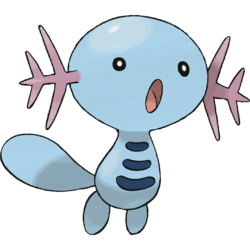

While they look cute, Wooper are a key part of the swamp ecosystem. These axolotl-like Pokémon seem harmless but actually carry a potent poison in their skin. This helps scare off predators that would like to eat them, such as Feraligatr. While axolotls are fully aquatic, Wooper can live on land or in the water. The purple structures that protrude from their cheeks are used to absorb the oxygen out of the water while they swim. Wooper also have an amazing ability to regenerate their limbs. Research is still being done on how exactly these animals are able to do this, but the research that's been done has already shown that macrophage cells play a role in the recovery of limbs. Macrophages in humans show up to a wound and clean it up. The key to figuring out how to recover limbs in humans lies in these little salamanders.
Whiscash
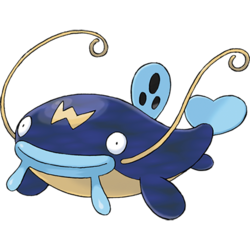

Our serpentine fish are the spitting image of catfish; even the name is an obvious word game between "whiskers" and "catfish."
These whiskers are technically called barbels or barbs when referring to a fish, but they are more commonly called whiskers due to the resemblance with the felines'. These barbels are Whiscash's eyes and ears as well as their taste buds; visibility when swimming in muddy water is almost non-existent. This means that Whiscash have developed pretty amazing sensors, but be careful! As incredible as they are, the barbs are rigid extensions of the happy fish's skins, and, although they won't sting you on purpose, touching them can cause small but discomforting wounds.
This Pokémon might look extremely innocent due to the smile they always have on their faces, but they actually have an insatiable appetite and they will eat whatever is available; it doesn't matter if it's dead or alive. They will eat smaller fish, some algae, and sometimes even Barboach eggs that are not theirs.
Whiscash are easily found while fishing, but it's really hard to catch them, as they are pretty heavy and long. The biggest one ever caught was around the 30 kg and 1.5 meters! The fisherman immediately released it after taking pictures and measuring this "little" guy, and no one ever saw it again.
Feraligatr
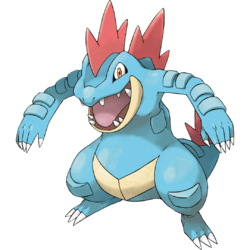

Feraligatr are the apex predators of the swamp, reaching over seven feet long; nothing messes with them. Feraligatr spend their time swimming around the swamp, eating whatever prey they can catch, such as Buizel, fish such as Barboach and Basculin, and frogs such as Politoed. While slow on land, Feraligatr can speed up to catch prey, reaching up to 11 miles per hour. For mating, female Feraligatr build nests on the shore of the water with vegetation, branches, and mud. The males perform a dance to attract the females to mate with them. After mating, females lay up to 50 eggs in the nest and cover the nest up with vegetation.
Alligators are cool in that the genders of the babies are determined by the temperature when they hatch; if the temperature is over 93° Fahrenheit (34° Celsius), they hatch as males, and if it's under that temperature, they hatch as females. Female Feraligatr are very protective of the nest so that other Pokémon, such as Linoone, Seviper, and Floatzel, do not eat the eggs.
Conclusion

There are a lot of Pokémon that can be found in the swamp. These are just a few examples, and all of them have their own impressive and unique characteristics. Investigating them is our job; they never stop amazing us with new facts and information that show us that the world of Pokémon is definitely a wonderful world to live in.
| « Previous Article | Home | Next Article » |